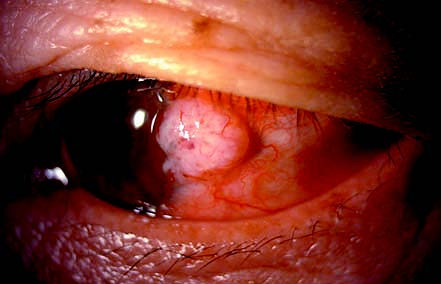Conjunctival squamous cell carcinoma (SCC) is a type of ocular surface squamous neoplasm (OSSN) and represents an aggressive malignant tumor originating from squamous epithelium. OSSN also includes conjunctival intraepithelial neoplasm (CIN), which is considered a precancerous lesion.
CIN is also referred to as Bowen's disease, conjunctival squamous dysplasia, conjunctival intraepithelial epithelioma, or conjunctival epithelial dyskeratosis. It can be classified into mild, moderate, and severe forms depending on the extent of dysplastic cell infiltration into the epithelium. When dysplastic cells involve the entire epithelial layer, it is diagnosed as carcinoma in situ. These lesions typically develop in exposed areas of the palpebral fissure, often near the limbus. The appearance may be papillomatous or gelatinous, with slow growth, and is often accompanied by mild inflammation and varying degrees of vascular abnormalities. The presence of thickened, abnormal blood vessels in the lesion suggests severe cellular atypia or malignancy.
SCC frequently affects middle-aged and older males. Small lesions may be asymptomatic, while larger lesions can cause a foreign body sensation or dryness. Involvement of the corneal optical zone may result in vision impairment. SCC is often unilateral and commonly located at the limbus in the interpalpebral zone.

Figure 1 Conjunctival squamous cell carcinoma in the left eye
The mass is located at the temporal limbus, presenting as a gelatinous, nodular lesion with prominent feeder vessels. The lesion involves the cornea, and pathological examination confirms squamous cell carcinoma.
The typical presentation includes a vascularized, gelatinous mass, leukoplakia-like lesions, or foamy epithelial infiltration adjacent to the cornea. Surrounding the tumor, dilated and tortuous feeder vessels may be observed. Infiltration into deeper tissues can occur, though metastasis is rare.
Treatment
The primary treatment method is wide surgical excision. Adjunct therapies such as cryotherapy and topical chemotherapy may help reduce the risk of recurrence.